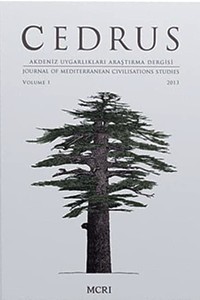Neapolis’ten Yemin Yazıtı
Neapolis’teki Vezirköprü, Samsun İmparatorluk yemini, keşfedilişinin yüzyıllarca sonrasında dahi Kuzey Anadolu Tarihi için önemini korumaktadır. Bu makalede yemin tekrar gözden geçirilmekte ve M.Ö. 3 yılında Paphlagonia Krallığı’ndan Pontos kraliçesi Pythodoris’in hâkimiyetine yeni geçmiş olan Neapolis kenti sakinlerinin sadakatlerini teyit etmek amacıyla yeminin edildiği öne sürülmektedir. Bu yemin, Augustus, Tiberius ve Gaius’a edilen benzer bir grup imparatorluk yemini gibi eyalet halkının sadakatini Roma’nın yüce hükümdârına sağlamak amacıyla edilmiştir.
Anahtar Kelimeler:
İmparatorluk Yemini • Neapolis Vezirköprü, Samsun • Augustus • Pontos
Oath Inscription From Neapolis
More than a century after its discovery the imperial oath from Neapolis Vezirköprü, Samsun remains an important document for the history of northern Anatolia. The present article revisits the oath and claims that it was taken in order to confirm the loyalty of the inhabitants of Neapolis in 3 B.C. when the city had recently been transferred from the Kingdom of Paphlagonia to that of Pythodoris, ruler of Pontus. This oath belongs to a group of similar imperial oaths, taken to Augustus, Tiberius and Gaius, all made with the purpose of securing the allegiance of the provincial population to the supreme rulers in Rome.
___
- Cass. Dio (= Cassius Dio, Rhomaika) Kullanılan Metin ve Çeviri: Cassius Dio, Roman History. Trans.: E. Cary – H. B. Foster, vols. I-IX. London 1914-1927 (The Loeb Classical Library).
- Ioseph. Bell. Iud. (= Flavius Iosephus Historicus, Bellum Iudaium) Kullanılan Metin ve Çeviri: Flavius Iosephus Historicus, The Jewish War. Trans.: H. S. J. Thackeray, vols. II-III. London - New York 1927-1928 (The Loeb Classical Library).
- Plin. epist. (= G. Plinius Caecilius Secundus “Genç”, Epistulae) Kullanılan Metin ve Çeviriler: Plinius Caecilius Secundus, Epistularum Libri Decem, Recognovit Brevique Annotatione Critica Instruxit. R.A.B. Mynors. Oxford 1963.
- Plinius, Genç Plinius’un Anadolu Mektupları. Çev.: Ç. Dürüşken – E. Özbayoğlu. İstanbul 2001.
- Strab. (= Strabon, Geographika) Kullanılan Metin ve Çeviriler: Strabons Geographika, mit Übersetzung und Kommentar Herausgegeben von Stefan Radt. Göttingen 2004.
- Strabon, Coğrafya. Çev.: A. Pekman. İstanbul 2000.
- Anderson 1903 J. G. C. Anderson, Studia Pontica I: A Journey of Exploration in Pontus. Brussels 1903.
- Anderson et al. 1910 J. G. C. Anderson – F. Cumont – H. Gregory, Studia Pontica III: Recueil des Inscriptions Grecques et Latines du Pont et de l’Arménie. Bruxelles 1910.
- Bekker-Nielsen 2013 T. Bekker-Nielsen, “Neoklaudiopolis’in Araştırma Tarihi Üzerine Notlar (Vezirköprü, Samsun İli)”. Höyük 6 (2013) 41-54.
- Bickerman 1980 E. J. Bickerman, Chronology of the Ancient World. New York 1980.
- CIL II Corpus Inscriptionum Latinarum. vol. II, Inscriptiones Hispaniae. Ed. A. Hübner. Berlin 1869.
- Cumont – Cumont 1906 F. Cumont – E. Cumont, Studia Pontica II: Voyage d’exploration Archéologique dans le Pont et la Petite-Arménie. Brussels 1906.
- Cumont 1900 F. Cumont, “Inscription Grecque de Vézir-Keupru dans l'ancienne Paphlagonie (Asie Mineure)”. Comptes-rendus des Séances de l'Académie des Inscriptions et Belles-Lettres 44/6 (1900) 687-691.
- Herrmann 1986 P. Herrmann, Der Römische Kaisereid. Göttingen 1986.
- Leschhorn 1993 W. Leschhorn, Antike Ären. Stuttgart 1993.
- Marek 1993 C. Marek, Stadt, Ära und Territorium in Pontus-Bithynia und NordGalatia. Tübingen 1993.
- Marek 2003 C. Marek, Pontus et Bithynia. Die Römischen Provinzen in Norden Kleinasiens. Mainz 2003.
- Mitchell 1993 S. Mitchell, Anatolia: Land, Men, and Gods in Asia Minor 1. The Celts in Anatolia and the Impact of Roman Rule. Oxford 1993.
- Mitford 1960 T. B. Mitford, “A Cypriot Oath of Allegiance to Tiberius”. JRS 50 (1960) 75-79.
- Ramsay 1893 W. M. Ramsay, “Micrasiana”. Revue des études Grecques 6 (1893) 251- 257.
- Sørensen 2015 S. L. Sørensen, “A Re-Examination of the Imperial Oath from Vezirköprü”. Philia 1 (baskıda).
- ISSN: 2147-8058
- Yayın Aralığı: Yıllık
- Başlangıç: 2013
- Yayıncı: Akdeniz Üniversitesi
Sayıdaki Diğer Makaleler
2008 Yılı Tralleis Kazısı Koroplastik Buluntuları
Tønnes BEKKER-NİELSEN, Marit JENSEN
Güney/Güneybatı Pisidia Sarnıçlarına Bir Örnek: Sia Çifte Sarnıcı
Eskiçağ Bilimleri’nin Türkiye’deki Geçmişi ve Geleceği Üzerine Sohbetler I
Makedonya Krallığı’nın Yükselişinin Arkasında Yatan Askeri, İdari ve Ekonomik Nedenlere Bir Bakış
DÜVER – YARIM ADA KAYA KABARTMALARI
ANDRİAKE SİNAGOGU’NDAN SEÇİLMİŞ ÖRNEKLERLE HELLENİSTİK VE ROMA DÖNEMİ SERAMİKLERİNE GENEL BİR BAKIŞ
